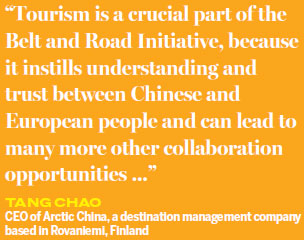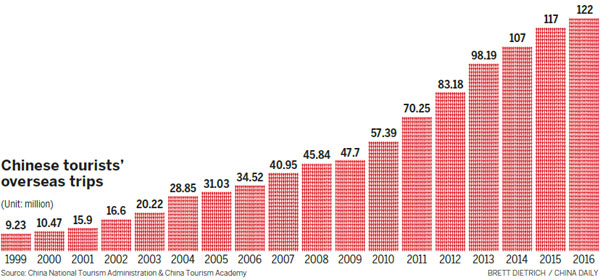A new era in travel
The number of Chinese visitors to Europe is booming, and they're increasingly looking for unique destinations and experiences
The tourism industries in both China and Europe are celebrating a new era of collaboration, characterized by unprecedented growth in visitor numbers and the increasingly sophisticated needs of visitors.
Growing tourism connectivity is being hailed by analysts as a crucial ingredient for enhancing cultural understanding, which is considered fundamental to the China-led Belt and Road Initiative, which seeks to boost trade and investment between China and the rest of Asia, as well as Europe and Africa.

Since China and the European Union signed an Approved Destination Status agreement in 2004, the number of tourists traveling between China and Europe has grown by an annual average of 10.6 percent.
Countries that have signed an ADS agreement with the Chinese government are allowed to receive Chinese tourist groups and promote their own destinations in China.
The year 2018 is EU-China Tourism Year, and conferences, exhibitions and events are planned with the aim of enhancing tourism understanding and improving collaboration.
"Chinese outbound tourism is entering a new era, characterized by unparalleled growth in tourist numbers, their increasing consumption powers and their rapidly growing level of international awareness," says Tim Wang, CEO of Elite UK Travel.
Tang Chao, CEO of Arctic China, a destination management company based in Rovaniemi, Finland, agrees.
"Tourism is a crucial part of the Belt and Road Initiative, because it instills understanding and trust between Chinese and European people and can lead to many more other collaboration opportunities in the fields of trade, investment and education," Chao says.
In 2016, Chinese travelers made a total of 3.49 million visits to European Union countries, but the potential to increase that number is immense, given that Chinese tourists made around 122 million overseas trips that year.
As well as being significant in their numbers, Chinese outbound tourists also have a reputation for being big spenders while on vacation. According to statistics from the tourism shopping tax refund company Global Blue, Chinese shoppers' duty-free spending in Europe during the first nine months of 2017 accounted for 28 percent of total sales.

The high spending habits and high growth numbers of Chinese tourists have made them a key focus for many European destinations.
Luxury shopping malls, designer shops and hotels are increasingly training Mandarin-speaking assistants and installing payment platforms that are familiar to Chinese tourists, including Alipay and UnionPay.
Alipay, China's largest mobile payment network, operates in 18 European countries. To use it, a Chinese shopper needs only to scan a QR code with their Alipay mobile app and the payment is made instantly through their mobile phone. The Chinese users pay in yuan, while the overseas retailers receive payment in their local currency.
"Such a small service can encourage immense spending growth," says Alexander Yin, chief financial officer at TGC, the parent company of ePassi, a Finnish payment terminal provider that works in partnership with Alipay. With ePassi's help, Alipay is now accepted at 700 points of sale in the country.
"Finland is often the first stop for Chinese travelers heading for Scandinavian countries. Traditionally, Chinese shoppers were reluctant to spend too much money in Finland because they preferred to save their cash for later stops. But now they can spend as much as they like with Alipay, without consciously calculating if they have enough cash left," Yin says.
After Finnair included Alipay in its in-flight payment infrastructure in January 2017, shopping on direct China flights doubled.
While the first wave of Chinese tourists focused on such destinations as London, Paris and Milan, tourists are now exploring other destinations.
"Chinese tourists are increasingly becoming sophisticated. Their choice of location reflects their preference for luxury, privilege and exclusivity," says Michel Gutsatz, a visiting professor of marketing at China Europe International Business School.
Gutsatz says one such example of a hidden gem is Le Marais in Paris, which was once the center of the Jewish community in the French capital but is now home to boutiques, art galleries, bars and restaurants.
"They want to show their family and friends in their photos that they have visited somewhere unique," he says.
This trend is confirmed by statistics from the Rezidor Hotel Group, which saw bookings from Chinese visitors rise by 100 percent in Finland, 69 percent in Sweden and 47 percent in Norway from 2015 to 2017.
The efforts of local tourism boards to attract Chinese tourists play a big role. In Rovaniemi, where it is sometimes possible to see the northern lights, and from which tourists can enter the Arctic Circle, the local tourism agency has partnered with the Jiangsu Television show We Are In Love to film episodes there and increase exposure of the destination within China.
Michael Wenderoth, associate professor of marketing at Spain's IE Business School, says the governments of European countries can also help grow their destinations' attractiveness by improving their safety, which he believes is the top consideration among Chinese outbound tourists. He cites as evidence a drop in the number of Chinese tourists to Europe in 2016 due to terrorism concerns.
The number of Chinese tourists traveling to Europe increased by 32 percent to 4.78 million in 2015, with growth strongest among those heading to Germany and France. That trend changed after the terrorist attacks in Paris in November 2015 that killed 130 people. In the first six months of 2016, the number of visas issued by the French government to Chinese visitors dropped by 15 percent compared with the same period in 2015.
The degree of difficulty in obtaining visas is another important factor. When the Czech Republic joined the Schengen visa area in 2007, it experienced a sudden influx of tourists, says Zhu Lingxin, founder of Sino Star, a Prague-based tour operator.
"Many Chinese tourists prefer visiting several European countries at once, so, before the Czech Republic's joining of Schengen, many found the need to obtain an additional Czech visa troublesome," Zhu says.
Before 2007, the number of Chinese visitors to the Czech Republic each year was so small that no official statistics existed, but that number grew to 300,000 in 2016.
The United Kingdom has also worked on simplifying its visa application process for Chinese visitors. In 2015, the UK government announced a new policy to simplify the visa application process, which allows visitors to use the same form for both their UK and Schengen applications.
The new program was created in response to lobbying efforts by the British Hospitality Association, which estimated that Britain loses out on £1.2 billion ($1.9 billion; 1.4 billion euros) of potential tourism revenue a year because wealthy Chinese tourists have chosen to visit Schengen countries, where one visa gives them access to 26 nations.
In recent years, training programs in which hospitality industry workers learn how to better cater to Chinese tourists have become popular. One such program is the GREAT China Welcome program, which was created by VisitBritain, the country's tourism authority. It has reached more than 500 hotels, attractions, retailers and tour operators in the UK. In Italy, a similar training program is being provided by the Italy China Foundation's Continuing Education School.
Although Chinese outbound tourism is booming, significant growth can also be observed in the other direction.
"European tourists are also increasingly visiting China, especially as China's international influence grows," says Olivia Ruggles-Brise, director of policy and communications at the World Travel and Tourism Council.
In particular, the 2008 Beijing Olympics and 2010 Shanghai Expo opened the world's eyes to China as a modern country and created huge tourism interest. Ruggles-Brise says the rapid development of tourist infrastructure in China has been very impressive.
In 2016, citizens from EU countries made a total of 3.1 million visits to China.
Patricia Yates, director of strategy and communications at VisitBritain, says knowledge sharing is very important. She adds that the UK and China have the opportunity to share knowledge about how to use tourism to promote economic growth in less-developed areas and rural regions.
At the UK-China People-to-People Dialogue in December, the governments of the UK and China agreed to further share knowledge and experience in this area.
Ouyang Xueyan contributed to this story.
cecily.liu@mail.chinadailyuk.com
Key events of China-EU tourism
2004: China and the EU sign an Approved Destination Status agreement in 2004, which makes it possible for EU destinations to receive Chinese tour groups and market their destinations in China for tourism purposes.
2007: The Czech Republic marks a new milestone in welcoming Chinese tourists, as it becomes a part of the EU's Schengen border-free area, meaning Chinese tourists no longer need to apply for a separate visa. The number of Chinese visitors to the Czech Republic grew from a negligible number before 2007 to almost 300,000 by 2016.
2014: VisitBritain launches the Great China Welcome program to teach retailers, hotels and attractions how to cater to Chinese visitors' needs. The program has now reached 500 British companies and organizations in the tourism industry.
2015: Luxury retailer Tripidi, at Frankfurt Airport, becomes the first European trader to accept Alipay, China's largest mobile payment network. This makes it possible for Chinese shoppers to make payments in 18 countries in Europe.
2015: The UK government announces a new policy to simplify the visa application process, which allows visitors to use the same application form for both their UK and Schengen applications.
2016: Jean-Claude Juncker, president of the European Commission, and Premier Li Keqiang decide that 2018 will be EU-China Tourism Year.
2016: Alipay launches its shopping festival 12.12 in December in the famous Santa Claus Village in northern Finland, giving discounts to Chinese shoppers with 70,000 merchants in 16 countries. The event is a milestone in encouraging Chinese tourists to further their shopping activities abroad.
2017: China and Denmark celebrate the 2017 China-Denmark Tourism Year. Denmark was the first country in Europe to celebrate a tourism year with China.
2017: The metropolitan area of Bologna is recognized by the China Tourism Academy as the first "Welcome Chinese Destination" city in Italy.
2017: The UK and Chinese governments agree during the 2017 People to People Dialogue in the UK that the two countries will share knowledge of how to use tourism to promote economic growth in less-developed and rural regions, particularly in the north of the UK.
2018: EU-China Tourism Year will launch in Venice on Jan 18.
|
Tourists visit an ice palace in central Switzerland. In 2016, Chinese travelers made a total of 3.49 million visits to European Union countries. Xu Jinquan / Xinhua |

|
A customer uses Alipay to pay for his hotel in Finland. Alipay, China's largest mobile payment network, is accepted at 700 points of sale in Finland. Cecily Liu / China Daily |
|
Visitors at Santa Claus Village in Rovaniemi, Finland. Provided to China Daily |
(China Daily European Weekly 01/12/2018 page1)





















